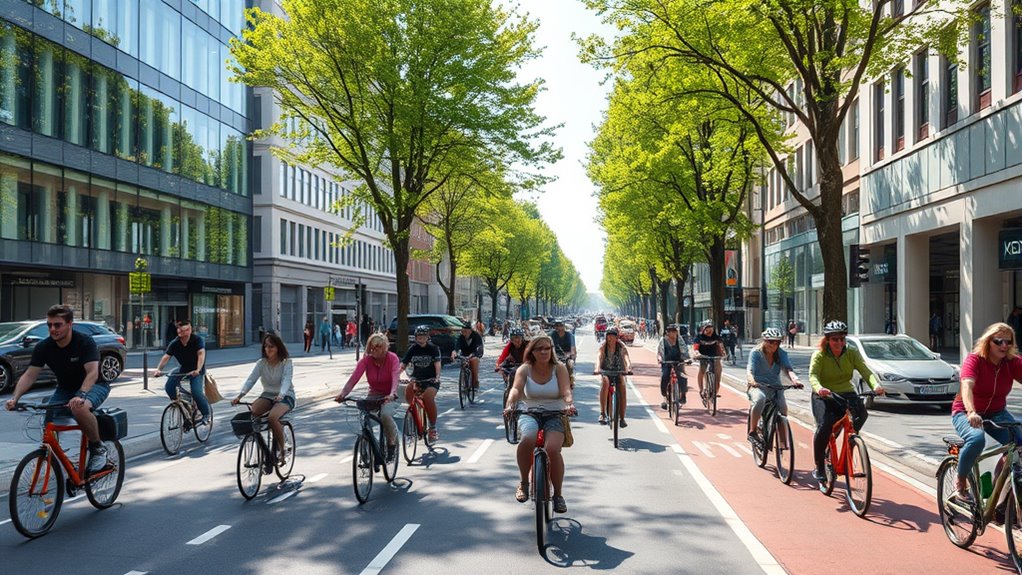To learn from Copenhagen’s success, see how their extensive, well-planned bike lanes and infrastructure prioritize cyclists. Flat terrain, secure parking, and city designs make cycling convenient for everyone. Policies limit car use and create a more bike-friendly environment. This fosters cleaner air, less congestion, and vibrant neighborhoods. Continue exploring to discover how these strategies turn a city into one of the world’s top cycling capitals, offering valuable lessons for urban transport.
Key Takeaways
- Extensive, well-maintained bike lanes and infrastructure prioritize safety and seamless integration into urban planning.
- Flat terrain, secure parking, and practical features make cycling accessible and convenient for all residents.
- Policies discourage car use in city centers, reducing congestion and promoting cycling as the primary mode of transport.
- Cycling reduces pollution, noise, and urban congestion, fostering healthier, more vibrant communities.
- Copenhagen’s investment in infrastructure and inclusive planning offers a scalable model for sustainable urban mobility.

Have you ever wondered why Copenhagen is often called the bike capital of the world? It’s because cycling isn’t just a mode of transport here; it’s a way of life. From a visitor’s perspective, you’ll quickly notice how seamlessly bikes blend into the city’s fabric. Bike lanes are everywhere, wide, well-maintained, and clearly marked, making it easy for you to navigate safely. The city has invested heavily in infrastructure that prioritizes cyclists, and it shows. You’ll see dedicated cycling bridges, tunnels, and intersections designed specifically to keep bikes moving smoothly and safely alongside pedestrians and cars. This infrastructure encourages you to choose your bike over other modes of transport, knowing you’re supported by a system optimized for cycling.
Copenhagen’s extensive, well-maintained bike lanes and dedicated infrastructure make cycling seamless and safe for everyone.
As you pedal through Copenhagen, you’ll find that cycling is accessible and convenient for everyone. The city’s flat terrain makes riding less tiring and more enjoyable, regardless of your fitness level. If you’re concerned about security, rest assured that bike parking is plentiful and secure, often with designated, sheltered racks close to major attractions, public transport hubs, and workplaces. You might notice that many locals have their bikes equipped with practical features — baskets for groceries, child seats for families, or sturdy locks for peace of mind. This adaptability makes cycling an attractive choice for daily errands, commutes, or leisure rides.
Copenhagen’s approach to urban planning revolves around fostering a bike-friendly environment. The city actively discourages car use within its core by implementing low-emission zones, reducing parking spaces for cars, and making streets more inviting for cyclists. This strategy not only improves air quality but also creates a more livable, less congested city. As you observe local residents, you’ll notice they often choose bikes over cars, which helps keep the city’s air cleaner and streets quieter. The city’s design also promotes social interaction by creating vibrant bike-friendly neighborhoods, where cycling is part of daily life and community bonding.
Copenhagen’s success in promoting cycling offers valuable lessons. Its commitment to infrastructure, safety, and inclusive planning makes cycling accessible for all ages and abilities. For you, as a visitor or resident, it provides a sustainable, efficient, and enjoyable way to experience the city. It’s a model that shows how investing in cycling infrastructure can transform urban environments into healthier, happier places to live and explore. If you want to embrace city life on two wheels, Copenhagen’s example proves that with the right support, cycling can become a natural, integral part of your daily routine.
Frequently Asked Questions
How Does Copenhagen Ensure Cyclist Safety During Harsh Winter Conditions?
You might wonder how Copenhagen keeps cyclists safe during harsh winters. The city invests in snow removal and de-icing on bike paths, ensuring clear, non-slippery routes. They also maintain well-lit, visible bike lanes and provide regular updates on road conditions. By prioritizing these measures, Copenhagen creates a safer environment, encouraging you to continue cycling comfortably even when the weather gets tough.
What Are the Key Policies Promoting Cycling in Copenhagen’s Urban Planning?
You’ll find that Copenhagen’s key policies promote cycling through extensive dedicated bike lanes, smart traffic management, and strict safety regulations. The city encourages cycling by integrating it into urban planning, making infrastructure bike-friendly, and offering incentives for bike commuters. These policies prioritize cyclist safety and convenience, making cycling a seamless, attractive option for residents. As a result, Copenhagen fosters a sustainable, efficient, and safe environment for all urban travelers.
How Does Copenhagen Handle High-Volume Bike Traffic During Peak Hours?
During peak hours, you’ll notice Copenhagen manages high-volume bike traffic efficiently by implementing dedicated bike lanes that are wide and well-maintained, reducing congestion and conflicts. You’ll also see strategic traffic signal prioritization, allowing bikes to move smoothly through intersections. These measures encourage safe, swift cycling even during busy times, ensuring you can commute comfortably. The city’s infrastructure and planning focus on keeping bike flow uninterrupted, making cycling a reliable choice.
What Incentives Encourage Residents to Choose Cycling Over Cars?
Imagine a city where bikes are as inviting as a warm embrace. You’re encouraged to cycle instead of drive through incentives like extensive bike lanes, affordable bike rentals, and safe, convenient infrastructure. These perks make cycling easier and more attractive, turning your daily commute into a pleasant journey. By prioritizing bike-friendly policies, residents like you find it natural to choose cycling, reducing traffic and boosting health and sustainability.
How Does Copenhagen Integrate Cycling With Public Transportation Systems?
You’ll find that Copenhagen seamlessly integrates cycling with public transportation by providing extensive bike parking at train stations and bus stops, making it easy to switch between modes. The city also offers combined ticketing options, allowing you to access bikes, buses, and trains with a single ticket. Clear signage and dedicated cycling lanes near transit hubs further streamline your journey, encouraging you to cycle more and rely less on cars.
Conclusion
As you explore Copenhagen’s cycling culture, remember that over 62% of residents commute by bike daily. This impressive statistic shows how effective dedicated infrastructure and a bike-friendly mindset can transform a city. By adopting some of Copenhagen’s strategies—like expanding bike lanes and prioritizing safety—you can help create a more sustainable, healthy urban environment. Embrace cycling, and see how it can revolutionize your city just like it did Copenhagen’s.









